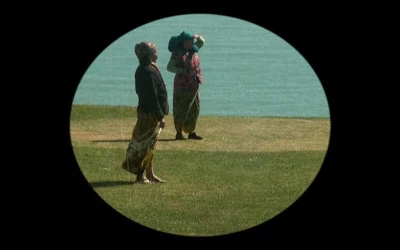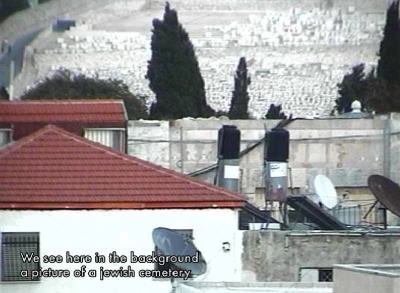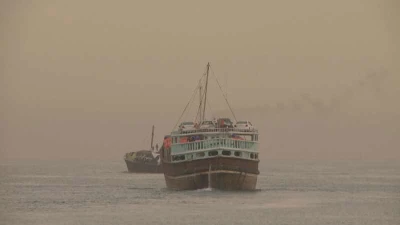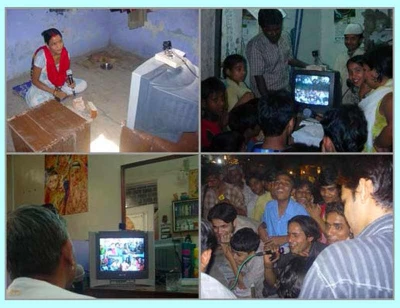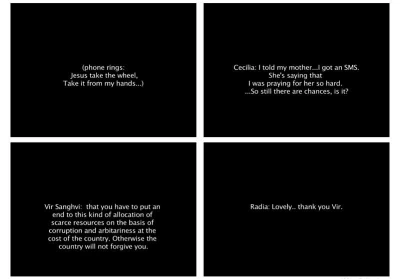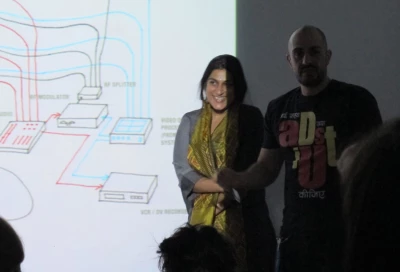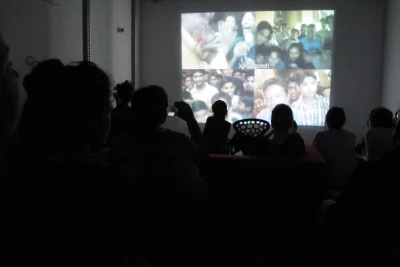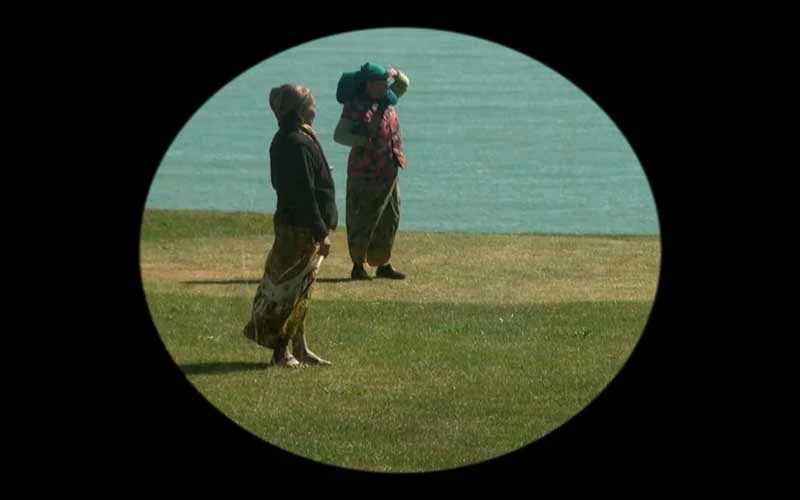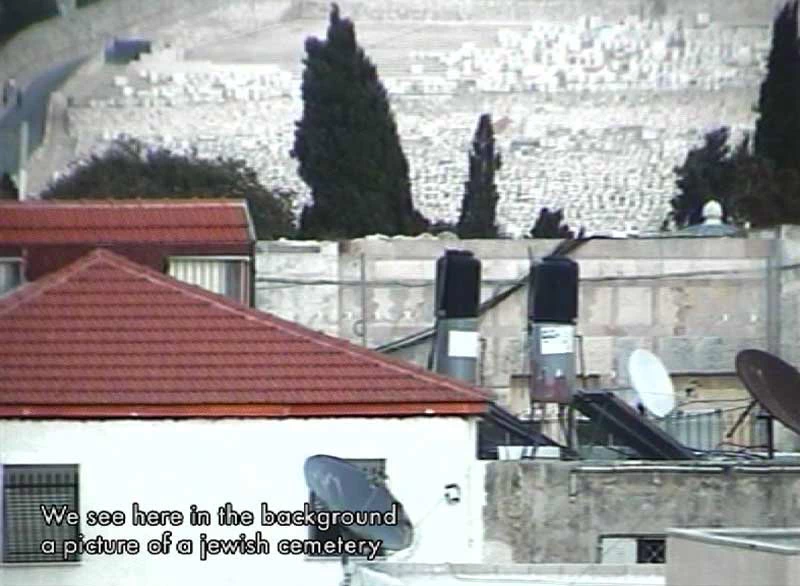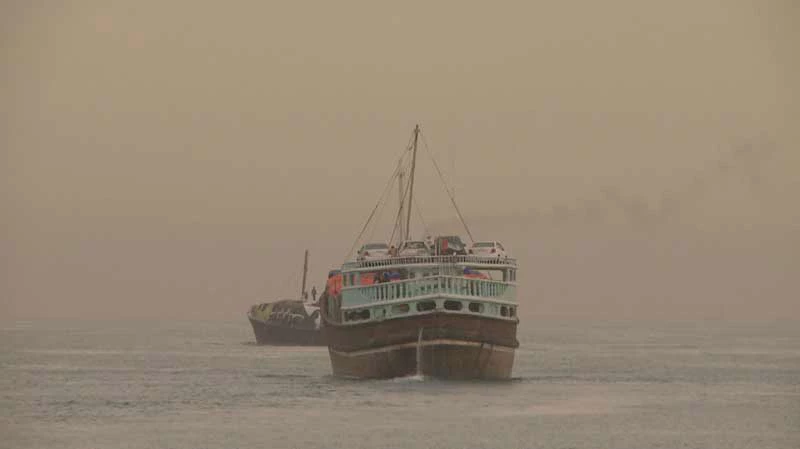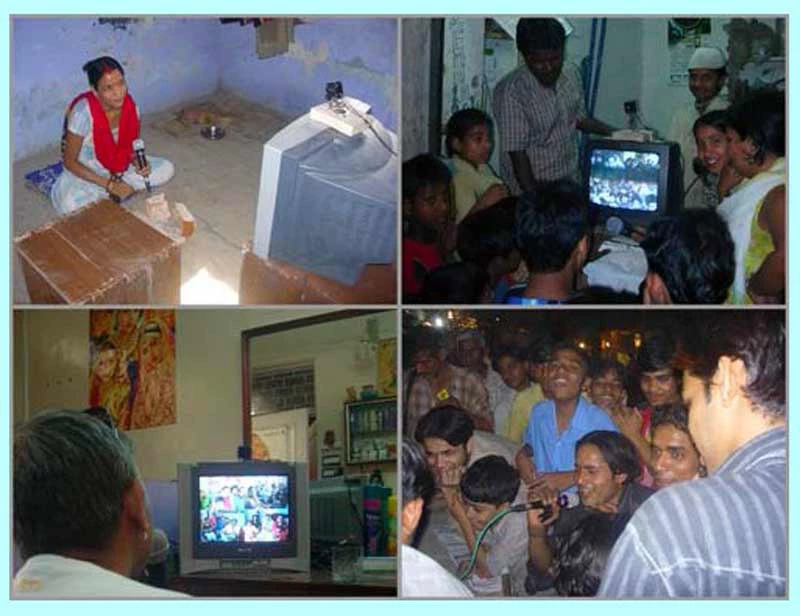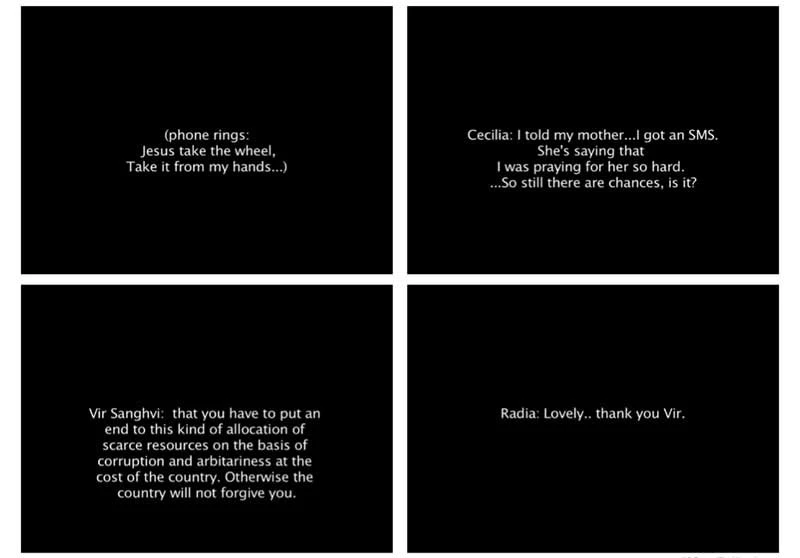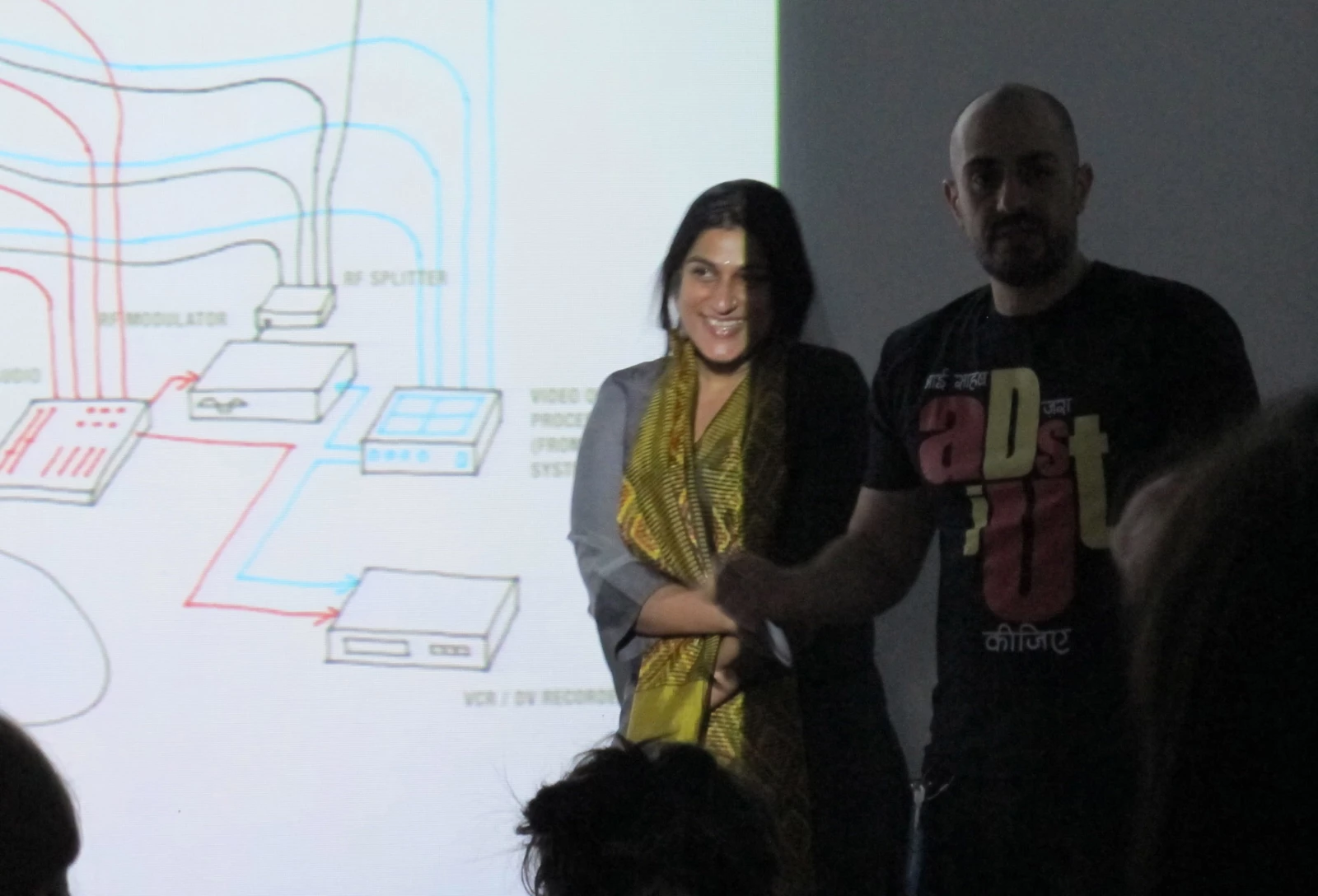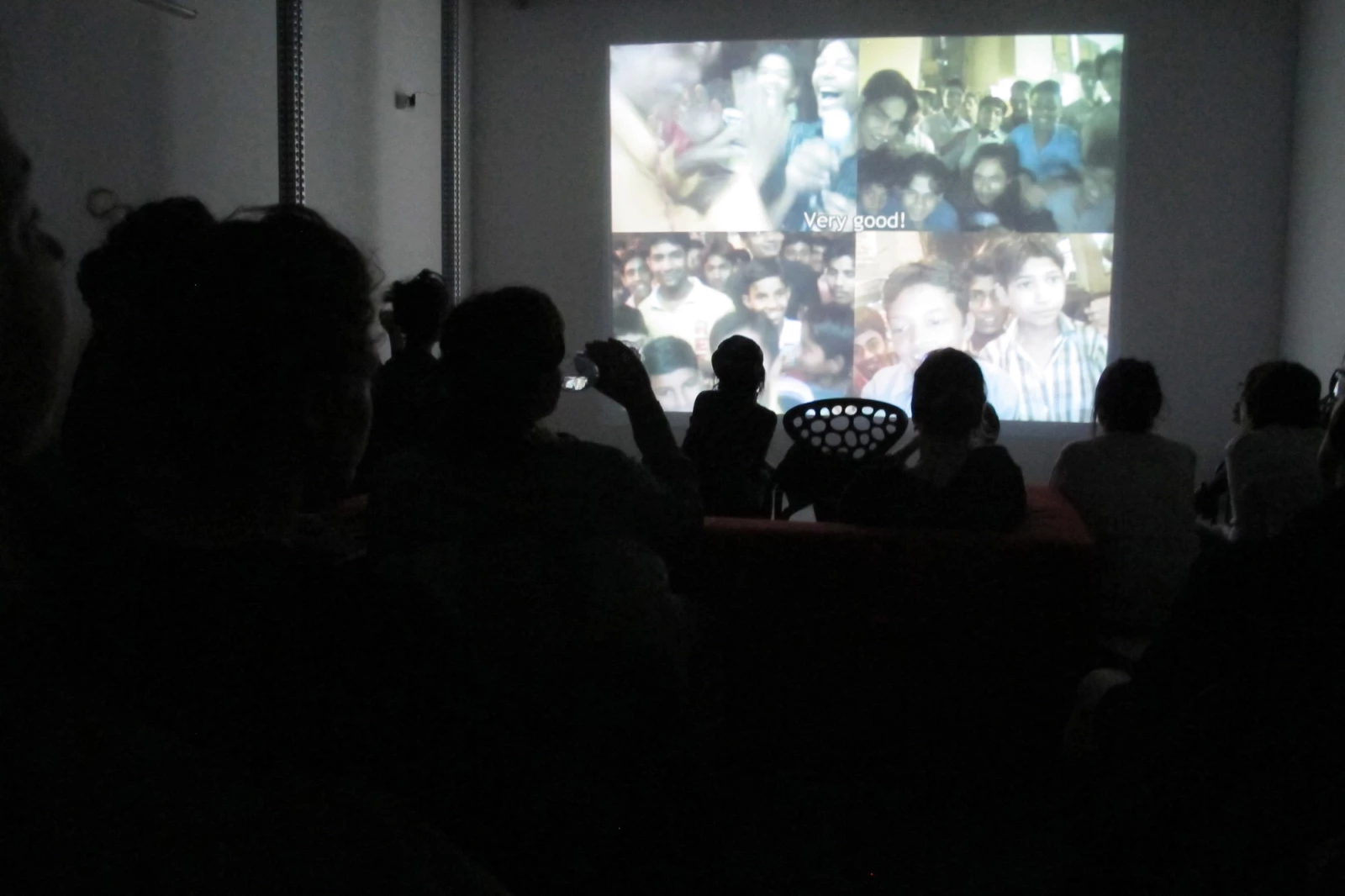Tales from the networked neighborhood: The cinema camp
21 - 22.03.2014
Tales from the Networked Neighborhood presents 5 films by CAMP, a collective of artists based in Bombay, and concerns the first Italian screening of their work as well as the first comprehensive focus on their audiovisual work in a cinematic context.
Shaina Anand and Ashok Sukumaran founded CAMP in 2007. Their recent feature film From Gulf to Gulf to Gulf was screened every evening for three consecutive months in an open-air cinema in Sharjah, one of the ports where the footage was shot, as part of the Sharjah Biennale program. At FID Marseille, where the film had its festival premiere, CAMP won the second prize. This was followed by a significant festival journey, from the Viennale to Doc Lisboa and the London Film Festival. One year after its debut, the film continues to be selected by film festivals. It will compete at the Ann Arbor Film Festival and will open the Images Festival in Toronto.
CAMP’s work is widely recognized in the art world. The elements that allowed their latest documentary to enter the cinema are not new in CAMP’s artistic practice: politics and geopolitics, empirical sociology, technological research, the ethics of ethnography, the limits of aesthetics.
CAMP’s work questions some fundamental issues: what can we hope for, what can others hope for, what can we rely on to hope, what gives us the right to define others, why is something art? From Gulf to Gulf to Gulf poses all these questions (and many more), merging them into a single formal spectacle staged by the very people who are the actors/protagonists of the film.
Incredibly, this happens for each of the 5 selected films. Yet “from one film to another to another” we encounter completely different forms, a completely new formal spectacle. And none of these forms is ever used gratuitously. The form can sometimes have roughness, but it is always “meaningful” in CAMP’s cinema. The stories are always told by a series of “unlikely suspects,” never falling back on classic ethnographic concepts.
We will have a unique opportunity, very different from a museum presentation, to immerse ourselves in the complete filmography of CAMP. And we will have plenty of time to discuss it with the author. The event will allow the Milanese audience to begin examining CAMP’s creative process and to conclude that their previous documentaries are at once great cinema and great art. If a simple reclassification allows these works to reach a wider audience, we are happy that this process can start from Milan. We are convinced that CAMP’s future films will be seen, heard, or felt intimately, so we believe it is a good idea to start from how it all began.
Text by Vassily Bourikas
This exploration of CAMP’s cinematic imagination will be preceded by a presentation on March 21 at DOCVA, Documentation Center for Visual Arts. It will be an opportunity to meet Shaina Anand from CAMP to illustrate, alongside CAMP’s work, the extended project <pad.ma>, a publicly accessible online archive, of which CAMP is one of the main initiators.
The entire pad.ma collection is available online and downloadable for non-commercial use. The design of the Archive allows for various types of viewing and constellation, which will be illustrated, narrated, and compared with methods starting also from the DOCVA archive.
The entire project is part of a series of curator residencies organized by Fondazione Pini in 2014 under the title RES Residenze per giovani curatori e organizzatori. Fondazione Pini has fostered a partnership with three prestigious Milanese institutions, Filmmaker, Peep Hole, and O’, each committed to selecting and presenting candidates for the RES projects with the aim of generating new international collaborations with the city of Milan.
Program
Friday, March 21
Careof, Fabbrica del Vapore
Via Procaccini 4, 20154 Milano
Free Admission
7:30 PM DOCVA Video Room
Khirkeeyaan, 2006, 17’ & Hum Logos, 2012, 50’
(followed by Q&A)
6:30 PM DOCVA
Performing Archive: conversation with Shaina Anand / CAMP
Contributions by: Martina Angelotti, Shaina Anand
KhirkeeYaan, 2006, 17’
TV feed (CCTV, CATV RF modulator, video splitter, audio mixer)
Language: Bengali, Nepali, Hindi, Urdu – with English subtitles
KhirkeeYaan is the exploration of an open-circuit TV system used as a local network for communication, micro-media generation, and feedback device. It is normally used as a security apparatus or employed in surveillance systems or for secret purposes.
Televisions and inexpensive surveillance equipment, accompanied by an RF modulator, microphones, audio mixer, and meters of coaxial cable were arranged to form participatory conversation systems for community use. The televisions and electricity, as well as the audience, were sourced locally, often drawing on diverse resources.
Four stations with four video cameras, each equipped with televisions and microphones, were installed within a 200-meter radius from each other. Cameras were placed above the televisions, and the audio-video channel was connected to a processor and an audio mixer. The result—sounds and images coming from all four stations—was routed back to the televisions, allowing the subject/viewer/performer/audience to interact with other participants. The video became the site for these interactions and conversations.
Hum Logos, 2012, 50’
Telephone audio with projected text.
Language: Hindi and English
The lobbyist is an orator, persuader of a group, and feeder of a network. In 2010, his conversations from the Government phone under surveillance were made public. They became TV audio-bytes, evidence of fraud, long transcripts with short URLs…
Hum Logos is the second act of CAMP’s project “The Radia Tap(e)s.”
Act I, Swearing-in Whispers, is a screenplay where some of these texts were grouped, trying to become images and sounds again. Hum Logos is a film that starts where the screenplay ends. It begins when some of the best journalists claim they were only lying to Radia “a source” on the phone, and their conversations had no basis or impact on reality.
Paradoxically, this opens a window onto the broader spectrum of rhetoric: including lies, shouts, memes, pen drives, bad connections, and family feuds pulsating through the nervous system of Indian democracy.
Saturday, March 22
Cinema Palestrina
Via Giovanni Pierluigi da Palestrina 7, Milan
Admission €7 for the viewing of all three films
6:00 PM Al Jaar Qabla Al Daar – The Neighbour Before the House, 2009-2011, 60’
8:00 PM From Gulf to Gulf to Gulf, 2013, 83’
10:30 PM The Country of the Blind and Other Stories, 2011, 60’
(The films are in original version with Italian subtitles)
Al Jaar Qabla Al Daar – The Neighbour Before the House, 2009-2011, 60’
CCTV video
Language: Arabic and English (Italian subtitles)
Al Jaar Qabla Al Daar shows a neighborhood in a state of permanent crisis. Spatial proximity does not produce any sense of community but rather the opposite. What was private space becomes public, what was private life becomes political. (Florian Schneider)
The material used in this film was produced by eight Palestinian families living in various suburbs of Jerusalem/Al Quds, a place where the usual meaning of the term “neighborhood” has been destroyed by occupation and conflict. It was shot over a month, between September and October 2009, with a CCTV camera equipped with PTZ (pan-tilt-zoom) installed by the residents on their homes or, in the case of evicted families, directly on neighbors’ houses.
The audio is a live commentary by those filming while watching and controlling the camera from inside their homes. Sometimes the voice searches for the image, sometimes the image provokes the voice, and sometimes the two get lost in distant landscapes describing more intimate thoughts. The footage was transformed into a feature film in 2011.
From Gulf to Gulf to Gulf, 2013, 83’
HDV, SDV, VHS, cellphone videos
Language: Kutchi, Hindi, Urdu, Arabic
A boat can have many functions: it can gather a society in the making, distribute goods, transport people and ideas through places that seem different from the past. Or it can create further paths of meaning, when combined with words such as “sovereign,” “pirate,” “container,” “free trade,” “money,” and “work,” until maritime history and economics say: “The End!”
The film is the result of four years of dialogue, friendship, and exchange between CAMP and a group of sailors from Kutch, who often docked at the port of Sharjah. Their journeys and those of sailors from Sindh, Baluchistan, and South Iran show us the world from different perspectives, not easily assimilated into a single nostalgic or nationalist vision. Instead, it follows the sea crossings of these groups of people who built their own boats, who navigate, and who are the authors of the footage, sometimes associating it with songs close to them.
The Country of the Blind and Other Stories, 2011, 60’
HD video through the telescope.
Language: English
What can it mean to extend the concept of “looking at the coast” to “filming the sea”? Are there national institutions for sea films? They should exist. Because if on the one hand, as anthropologist Michael Taussig describes it, the modern sea is an image, a wallpaper backdrop for a Malibu or Folkestone lifestyle; on the other hand, in its mostly invisible movements, the seas carry over 90% of all world trade. So from any coast, the sea appears as an image and at the same time it is not.
Images of the sea remind us of this precise situation: what can be seen is always and only the surface, the tip of an iceberg. One eye or two? The inorganic, technological eye not only extends but exacerbates human vision (for example, it can also worsen it). In a sense, every optical instrument produces a new visual medium, as happens with painting or television. A telescope can also become a medium, as can radar. These mediations and their effects are part of a parasitic exchange system that also includes film and photography. For example, in the 18th century, the seaside camera obscura, invented before cinema, created long queues and a high price was paid just to see an image of the place one had just arrived from. This kind of power is not only attributable to technical issues but is also linked to context: the line was longer when there were lovers on the beach.
Bio
CAMP is a collective founded in 2007. The founders are Shaina Anand (filmmaker and artist), Sanjay Bhangar (software programmer), and Ashok Sukumaran (architect and artist). While CAMP was establishing itself in Bombay, artists Anand and Sukumaran were gaining recognition through their individual practices. Sukumaran received the first prize of the UNESCO Digital Arts Award in 2006 and the prestigious Golden Nica of the Prix Ars Electronica in 2007. He has lectured at Tate Modern and participated in the Singapore Biennale in 2006. Anand has produced a series of projects well received by media specialized in contemporary imagery and has exhibited at Frankfurter Kunstverein, Serpentine Gallery London, Nottingham Contemporary, Cornerhouse Manchester, Khoj and Sarai New Delhi, Powerplant Toronto, among others.
The reason for CAMP’s existence is the production of large-scale art works presented over long periods. CAMP merges film, video, installations, software, publicly accessible archives, and public programs with a broad enough interest to include technology, film, and theory. The projects created by CAMP over the last five years have demonstrated how far technological experimentation and artistic form can be compatible. Their work closely follows global phenomena: ships, CCTV, the emotional state of workers and watchers, telephone interceptions, cinematic, digital, and energy media. All this is realized thanks to a deep intimacy with the material, a political vision, care for form and experience, as well as a truly unique combination of talents, evident in the global reach of their production and the mark it has left on the global art market.
Selected participations in exhibitions and events: Sharjah Biennial (2013), dOCUMENTA 13 (2012), Gwangju Biennial (2012), New Museum Triennial (2012). CAMP has created the online video archive , and the archive of new cinema . (Their recent experimental documentary feature From Gulf to Gulf to Gulf received a Jury Mention at the Festival International de Cinema de Marseille and was screened at BFI London Film Festival, DocLisboa, Viennale, among others.
Vassily Bourikas is a film curator, graduated from the University of Newcastle and the Universität der Künste in Berlin. Until 2004, he directed current affairs documentaries for public television in Belgium and Greece. Since 2005 he has curated programming for numerous European festivals. Until 2012, he was the artistic director of the Experimental Forum at Thessaloniki Film Festival and currently curates a section of the Athens Avant-Garde Film Festival. He is co-founder of the independent film lab LabA in Athens, which he has directed since 2009.
Residecy
Vassily Bourikas
8.01 > 22.01.2014
10.03 > 24.03.2014
In collaboration with: Filmmaker Festival,
Fondazione Pini
Vassily Bourikas, independent curator, mainly focuses on experimental cinema, during a research period supported by Fondazione Pini.
In collaboration with Filmmaker Festival, a public event will be presented to deepen the understanding of contemporary Indian video production through the screening of three films at Cinema Beltrade and the talk Tales from the Networked Neighborhood curated by Careof on the themes of the archive.
Shaina Anand, Ashok Sukumaran
21.03 > 24.04.2014
In collaboration with: Filmmaker Festival, Fondazione Pini
Shaina Anand and Ashok Sukumaran were invited by Careof to present the online archive pad.ma within the project Tales from the Networked Neighborhood in collaboration with Vassily Bourikas, Filmmaker Festival, and Fondazione Pini.
The project is part of a broader focus that Careof dedicates in 2015 to Performing Archive, inviting some of the main national and international protagonists in the practices of video archiving to share their experiences.
At the same time, the two artists will reflect on and conduct research in the DOCVA archive.
